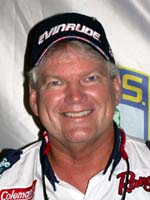
|
Features
|
|
|
|
Books
|
|
|
|
Fun & Games
|
|
|
|
Contact Us
|
|
|
John's Journal... Entry 253, Day 1
BEST NEW TACTICS OF THE PROS
Three of the Latest Techniques
Editor's Note: Have you wondered what's hot and what's not in the world of bass fishing? Has a new tactic caught on fire, promising to change the way we all fish for bass like dropshotting and flipping have in years past? Or, have anglers re-explored and dusted-off old techniques that once again have proved their value as significant bass-catching strategies? What's the inside scoop on the way professional bass anglers fish to produce the most and the biggest bass? Here's the answers to these questions as we all look forward to the 2004 Bassmaster Classic to be held at Lake Wylie in July, 2004.
 Tom
Mann, Jr.: From Skeptic to Believer - Tom Mann, Jr. from Buford, Georgia,
fished in his eighth Bassmaster Classic in 2003. Throughout his career,
Mann has had 18 top-10 finishes. "The newest tactic for me that I haven't
used before this past year is I fished the new Senko worm from Gary Yamamoto
Custom Baits," Mann reports. "I caught a lot of bass on the Senko lure
this past year. When this lure first came out, I thought of it as a big
fat worm. Then as I learned how to rig the lure properly and how to fish
it, I started taking numbers of bass on it. I rig the Senko on 14-pound-test
line with a No. 5/0 hook and no weight. Some people rig this worm wacky
style, but I don't like to fish that way. I Texas-rig my Senko. The tactic
I use to rig the Senko that produces best for me is to remember that a
Senko has a blunt end and a sharp end. If you hold the Senko up and let
it free fall, you'll notice the pointy end of the worm actually has a
little curvature in it. The curvature is not a large one, but the Senko
is poured into its mold like that. You must have the curve of the Senko
pointing up and the hook on the bottom (blunt end) of the lure to create
the side-to-side motion you want to get from the Senko. You can rig a
Senko any way, and it will work. However, if you rig the Senko like this,
I've found you'll catch more bass."
Tom
Mann, Jr.: From Skeptic to Believer - Tom Mann, Jr. from Buford, Georgia,
fished in his eighth Bassmaster Classic in 2003. Throughout his career,
Mann has had 18 top-10 finishes. "The newest tactic for me that I haven't
used before this past year is I fished the new Senko worm from Gary Yamamoto
Custom Baits," Mann reports. "I caught a lot of bass on the Senko lure
this past year. When this lure first came out, I thought of it as a big
fat worm. Then as I learned how to rig the lure properly and how to fish
it, I started taking numbers of bass on it. I rig the Senko on 14-pound-test
line with a No. 5/0 hook and no weight. Some people rig this worm wacky
style, but I don't like to fish that way. I Texas-rig my Senko. The tactic
I use to rig the Senko that produces best for me is to remember that a
Senko has a blunt end and a sharp end. If you hold the Senko up and let
it free fall, you'll notice the pointy end of the worm actually has a
little curvature in it. The curvature is not a large one, but the Senko
is poured into its mold like that. You must have the curve of the Senko
pointing up and the hook on the bottom (blunt end) of the lure to create
the side-to-side motion you want to get from the Senko. You can rig a
Senko any way, and it will work. However, if you rig the Senko like this,
I've found you'll catch more bass."
 Roland
Martin: Buzz the Shallows - Roland Martin, of Clewiston, Florida, has
won the title of Angler of the Year nine times and 19 BASS tournaments
during his career as a professional angler. Among his other achievements,
in 2001, the Bass Fishing Hall of Fame selected Martin for inclusion."
2003's bass fishing was different from other years because of the bad
weather," Martin remembers. "One tactic that was new and different I used
this year on Santee Cooper, where I once guided, was to fish a buzzbait
for shallow-water bass. I used a buzzbait in some of the same areas that
30-years ago I fished with a spoon. With the electronics we have now,
we can fish better than in years past -- enabling us to find more shallow-water
cover and fishing that cover efficiently. Shallow water is an area where
most bass fishermen don't use their depth finders. Yet most bass hold
in shallow water. Knowing the depth where bass are concentrating is critical
to your bass-fishing success. Little ditches in 2 to 3 feet of water can
hold some really big bass. When I swim a buzzbait in 2 feet of water,
and it passes over a small ditch in 3 feet of water, the bass only has
to move a few inches to take that big bait. However, you won't see that
1-foot drop from a 2-foot bottom, if you don't use your depth finder in
shallow water."
Roland
Martin: Buzz the Shallows - Roland Martin, of Clewiston, Florida, has
won the title of Angler of the Year nine times and 19 BASS tournaments
during his career as a professional angler. Among his other achievements,
in 2001, the Bass Fishing Hall of Fame selected Martin for inclusion."
2003's bass fishing was different from other years because of the bad
weather," Martin remembers. "One tactic that was new and different I used
this year on Santee Cooper, where I once guided, was to fish a buzzbait
for shallow-water bass. I used a buzzbait in some of the same areas that
30-years ago I fished with a spoon. With the electronics we have now,
we can fish better than in years past -- enabling us to find more shallow-water
cover and fishing that cover efficiently. Shallow water is an area where
most bass fishermen don't use their depth finders. Yet most bass hold
in shallow water. Knowing the depth where bass are concentrating is critical
to your bass-fishing success. Little ditches in 2 to 3 feet of water can
hold some really big bass. When I swim a buzzbait in 2 feet of water,
and it passes over a small ditch in 3 feet of water, the bass only has
to move a few inches to take that big bait. However, you won't see that
1-foot drop from a 2-foot bottom, if you don't use your depth finder in
shallow water."
 Mike
Wurm: Fish More to Catch More Bass - Mike Wurm from Hot Springs, Arkansas,
began fishing professionally in 1992. In 2003, Wurm qualified for his
seventh Bassmaster Classic and finished seventh on the Bassmaster Tour.
"I fished a lot of techniques this season that I'd used in the past,"
Wurm explains. "But I also started fishing with Strike King's new 3X lures.
Because the 3X material was so tough, I only had to take three or four
each of worms, lizards, jerkbaits and grubs with me to fish with all day,
instead of having to carry 1 to 2 pounds of each type of soft-plastic
lure. Since I have fewer soft plastics with me, I have more storage space.
Too, I easily can find the type, the color and the size of lure that I
need faster. Also the 3X material doesn't tear up as easily as soft plastics
do, which means I gain fishing time because I don't have to constantly
replace torn-up plastic lures. More fishing time translates to my locating
and catching more bass per day. The 3X material is so buoyant that it
allows me to present the bass with a lure they've never seen before. Because
of the buoyancy, the 3X plastics have tails that float up from the bottom
instead of lying flat. Real worms don't just lie on the bottom, and the
3X action gets me more strikes."
Mike
Wurm: Fish More to Catch More Bass - Mike Wurm from Hot Springs, Arkansas,
began fishing professionally in 1992. In 2003, Wurm qualified for his
seventh Bassmaster Classic and finished seventh on the Bassmaster Tour.
"I fished a lot of techniques this season that I'd used in the past,"
Wurm explains. "But I also started fishing with Strike King's new 3X lures.
Because the 3X material was so tough, I only had to take three or four
each of worms, lizards, jerkbaits and grubs with me to fish with all day,
instead of having to carry 1 to 2 pounds of each type of soft-plastic
lure. Since I have fewer soft plastics with me, I have more storage space.
Too, I easily can find the type, the color and the size of lure that I
need faster. Also the 3X material doesn't tear up as easily as soft plastics
do, which means I gain fishing time because I don't have to constantly
replace torn-up plastic lures. More fishing time translates to my locating
and catching more bass per day. The 3X material is so buoyant that it
allows me to present the bass with a lure they've never seen before. Because
of the buoyancy, the 3X plastics have tails that float up from the bottom
instead of lying flat. Real worms don't just lie on the bottom, and the
3X action gets me more strikes."
For more information about Gary Yamamoto's Custom Baits visit www.yamamoto.baits.com.
To learn more about Strike King's lures, go to www.strikeking.com.
TOMORROW: THREE MORE BEST WAYS TO TAKE BASS
Check back each day this week for more about BEST NEW TACTICS OF THE PROS ...
Day 1 - Three of the Latest
Techniques
Day 2 - Three More Best Ways To Take Bass
Day 3 - Three More Pro Bass-Catching Methods
Day 4 - Three Pros Teach You
Day 5 - Three Bass Tactics That Work